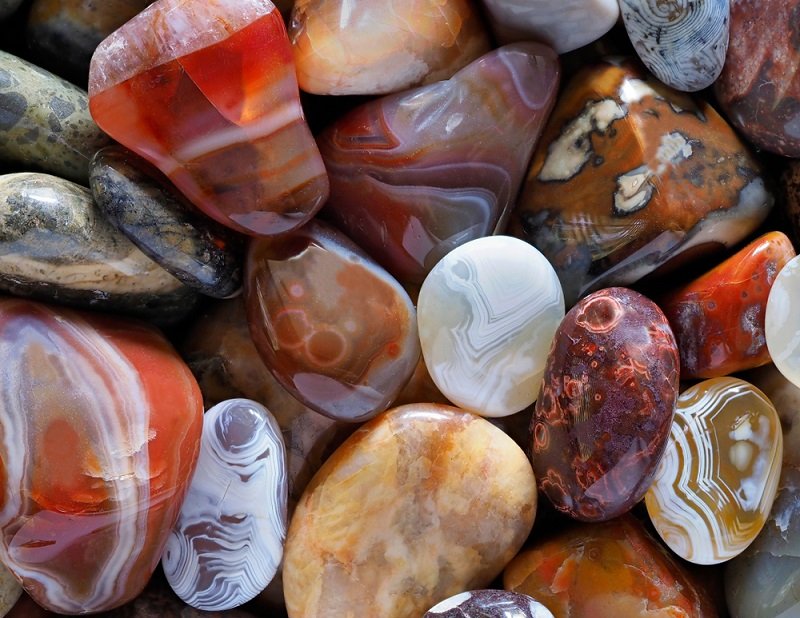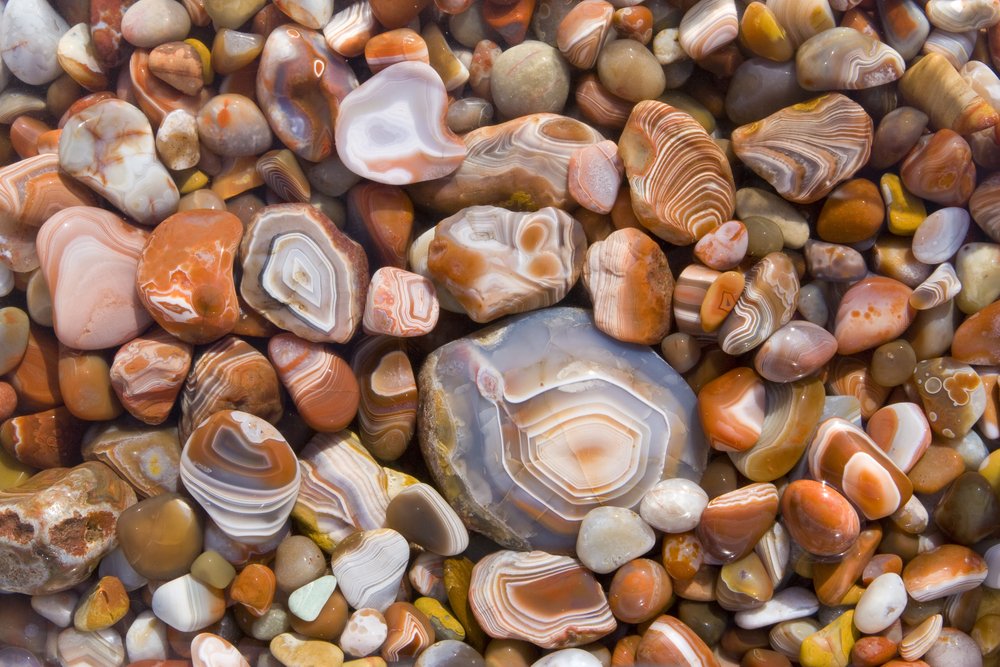Agates are primarily made of chalcedony, a form of silica dioxide (SiO₂), and are known for their hardness and variety. They form over thousands of years within other rocks’ cavities, often in volcanic environments.
What Is Agate Made Of?
Agates are primarily made of chalcedony, which is a form of silica dioxide(SiO₂). It’s the same stuff that makes up glass, quartz crystals, and even opals.
The defining characteristics of minerals usually come from their crystalline structure. Chalcedony is cryptocrystalline. The term’s root reveals the structure: crypto means hidden. These microscopic crystals are hard to see even under a microscope.
Chalcedony exists on a continuum of cryptocrystalline SiO₂, which includes flint and chert. The defining characteristic is that chalcedony is transparent.
Traditionally, agate referred to banded varieties of chalcedony. These days it’s used for any stones with inclusions that are comprised primarily of transparent chalcedony.
These range from relatively mild banded stones to stunning Turkish agate. The variety of stones available for an agate collector is insane.
Agates are very hard, running a 7 on the Moh’s scale. This makes them perfect for carving or polishing, They have a long history of use in jewelry and as ornaments. Their hardness makes them a forgiving stone for beginners. They also take a long time to work.
Agate is a translucent variety of microcrystalline quartz. It is used as a semiprecious stone when it is of desirable quality and color.
Hobart M. King – geology.com

How Are Agates Formed?
Agates are formed within the crevices and cavities of other rocks. The environment in which agate form must be acidic to neutral in nature. Agates are formed over thousands of years by the accumulation of silica-rich groundwater inside these rock cavities.
The majority of these chalcedony veins form within the voids of volcanic igneous rocks and plutonic igneous rocks. Igneous rocks have a greater propensity to retain groundwater for extended periods of time. Consequently, the agates form banding layers that are generally parallel to the cavity walls over time.
Agates are neither sedimentary, metamorphic nor igneous. In actuality, agates cannot be classified as any of the three geologic rock types. Gem enthusiasts also debate whether or not it is even a mineral. As a result of its amorphous physical properties and geochemical composition, agates are considered a mineraloid in the scientific field of mineralogy.

Types of Agate
A comprehensive list is almost impossible, especially since some of the most stunning agates are only known by the name of their location.
In general, however, we can break down agate into a few categories:
- Banded Agate- Banded agates usually lack serious inclusions. Instead, they’re comprised of layers of different colored material. The difference is sometimes subtle, but the most sought-after banded agates have bright contrast and sharp lines.
- Moss Agate- These agates have inclusions that resemble moss or other small plants. They occur in a wide variety of colors, but the majority is simply green. They’re usually exceptionally transparent, creating a lot of depth when examined closely.
- Plume Agate- Similar to moss agate, but generally with a more robust structure in the inclusions. Opinions will differ on how to categorize those agates which fall in between, but generally plume agate’s primary color is orange.
- Dendritic Agate- Dendritic agate has tree-like inclusions, usually black on a milky background. They’re readily distinguishable from other types of agate and common in some areas. Not to be confused with the similar dendritic common opal.
- Iris Agate- A clear specimen that displays rainbow colors when light hits at the right angle. High-grade collector specimens are highly sought after but they’re rarely used in jewelry as the optics need to be just right.
- Fire Agate- An agate that contains very thin layers of iridescent iron minerals. They’re usually contained in clear chalcedony, and cut so that the 3D bubble-like structure of the inclusions can be seen.
- Eye Agate- Displays round, banded circles across the surface of the stone. These spots can be monochromatic or occur in complex, beautiful patterns depending on the origin of the stone.
- Tube Agate- Has tiny mineral tubes running through the stone, which display across the background when cut and polished.
Read more: 9 Different Types of Agate
- Online rock and mineral club for collectors of all levels!
- Find community with like-minded rock and mineral enthusiasts.
- Monthly Giveaways!
- Free Access to Entire Digital Library of Products (current and future products)*


